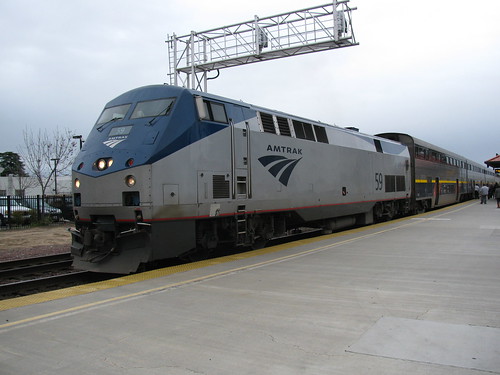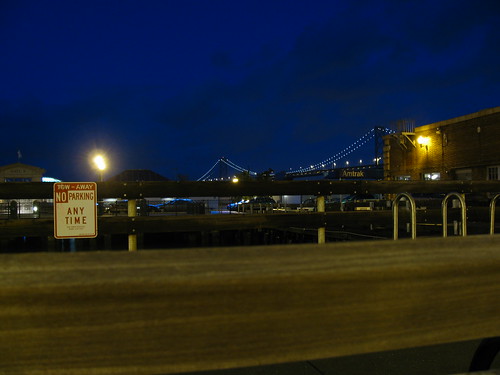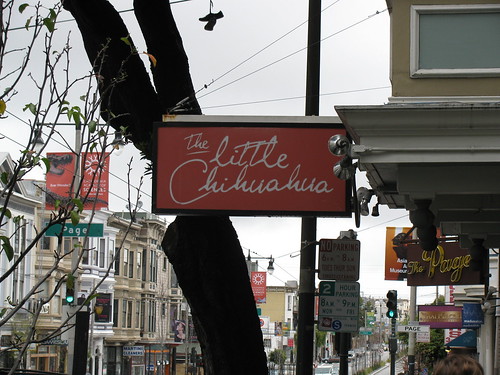
There's nothing quite like the feeling of having a view like this out your window first thing after waking up. San Francisco continues to have its own unique character and beauty, and always feels as if it's a foreign nation when compared to Riverside. Now, granted, I did have to actually open and lean out of the window of the hotel to get this shot... but it's still a great view.
After cajoling my lady out of bed a little after 11, we once again went out in search of food. We filled up our Clipper cards at the Walgreens and went next door to Kate's Kitchen, an apparently popular breakfast spot on Haight. Dani had their French toast, which she enjoyed. I should have gotten the French toast, but for some reason chose to order the pancakes with strawberry and banana. Strawberry and banana, right? Mmm, delicious. Except that I didn't notice the next line on the menu board- "lemon curd." Also, the pancakes themselves were made from cornmeal, rather than flour. The combination made me regret not getting the French toast- it wasn't bad, per se, but it wasn't what I'd expected.
After breakfast, we caught the Muni to Golden Gate Park (which, by the way, was where we spent most of our time this trip.) Dani had never been to San Francisco's answer to Central Park, and it is certainly large enough to occupy a weekend's exploration. We didn't even come close to seeing it all. (Note that those unfamiliar with The City may confuse Golden Gate Park with Golden Gate NRA. The latter is at the north end of The City, around and under the Golden Gate Bridge. The former is several miles to the south of the iconic bridge, between the Richmond and Sunset neighbourhoods and to the west of the Haight.) On the way, we ended up changing buses at the famed intersection of Haight and Ashbury. My impression was that the stores there were trying very, very hard to capitalize on the counter-cultural impressions that that location invoked- and wouldn't that be against the spirit of the cultural revolution anyway? Either way, here's me on the corner, under an inexplicable mass of dangling shoes.

We wandered the park for a while before Dani decided to visit the Conservatory of Flowers. This beautiful old museum was built in 1878 and is home to thousands of species of exotic plants. We managed to tailgate on the end of one of the guided tours, which was excellent. It was also an extremely interesting experience to be in the middle of a 90-degree, humid rainforest in San Francisco in March. (Outside it was in the low 60's and drizzling, as is the custom in The City.) Of course, the best part of the Conservatory is the photos. I'll leave it to Dani to post up the rest (hint hint, honey!), but here's a few choice ones. Also, remember that the really good photos are the ones I took. :D



Also, creepy carnivorous pitcher plants. Om nom nom.

After getting our fill of flowers (and humidity), we decided to try to find that ever-present feature of American city parks: pedal boats. Yeah, cheesy, I know, but it's sort of our tradition. We ambled/bused over to Stow Lake and found the pedal boat stand closed. (Also, we found it outrageously expensive: $20/hr!) We did, however, find several very friendly Canada geese.

We sat at the boathouse on Stow Lake a while, enjoying the (no-longer-raining) weather and the pleasant landscaping of the park. (Stow Lake, while large, is also man-made.) On our walk back, I briefly crossed the bridge on to Strawberry Hill, and island in the middle of the lake. We also encountered highly-social squirrels, whose tiny psyches were clearly torn between an instinctual fear of large creatures and a learned understanding that those creatures will find them adorable and feed them.

We also had some pretty great views of Sutro Tower. A lot of people see the Golden Gate as the symbol of San Francisco, but Sutro Tower has always been my favourite structure. You can see it easily on a clear day from most places, but it's almost teasing in the way it can disappear in the trademark San Franciscan fog.

We made arrangements to go visit my cousin in Alameda, and I've always wanted to take a ferry across the bay, so we made our way back to Market Street. Along the way, we found ourselves distracted by several things. First, there was a busker with a drum set near Montgomery St. Station, so we stopped to listen a while- he was good! Plus, how many buskers bring a full drum kit?

As the 6:40 ferry departure drew near, we started leisurely making our way towards the ferry building at the Embarcadero. However, we got sidetracked by a shop on the street. Daiso Japan is kind of like a Japanese 99 cent store, and is full of all sorts of strange, small, curious and useful stuff imported from Japan. We bought around $10, but spent so much time in the store that our leisurely stroll down Market turned into a mad dash for the ferry slip. We were there at 6:35, five minutes early for the scheduled 6:40 departure... and just in time to watch the ferry sail off into the distance. We ended up taking BART to 12th St. in Oakland and getting my cousin to pick us up there instead of the ferry terminal. (On the way, we were also just in time to see the beginnings of Critical Mass, including one nearly-naked male cyclist. Thankfully, no photos.)
The difference between Oakland and San Francisco is striking. 12th St. and Broadway in Oakland looks, physically and architecturally, very similar to Market St. and Montgomery in San Francisco- high-rise office towers, ground-floor retail, frequent at-grade and below-grade transit. The big difference between the two is people. 6pm on a Friday night, Market is a clamoring throng of people going every which way you can imagine. Broadway is empty, plain and simple. I think there may have been one other guy waiting for the bus across the street. It was a ghost town. The actual, physical configuration of land use and infrastructure is very similar in both places, so the difference must be a social one. Perhaps it's Oakland's history of rocky race relations, or perhaps it is other social ills such as poverty and crime- although neither was immediately evident as I stood there- but Oakland is clearly a place that could be wonderful.
The evening that followed was lots of fun. We went out for hamburgers at Pearl's, waded through the closeouts at a soon-to-be-closed Border's, got some adult beverages and played Munchkin and Scattergories into the wee hours. At some point, Dani managed to misplace her voice- she didn't find it until after we got home! She and I then had the pleasure of riding a bus at 3am- yes, they run!- back to San Francisco, along with the distinctly odd feeling of being two of three passengers on a 60-foot articulated bus. Upon our return to Market Street, we ended up taking a taxi back to the hotel (because it was cold, wet, and very late). It turns out that, had we waited for a few more minutes, the Muni N-OWL would have taken us within a block of our hotel. You live, you learn, you get more impressed with Muni.





